

» Listen to the Radio Show Archive Alex Jones. Simon Peter versus Simon the Sorcerer. This is a great expose by the late Dr.
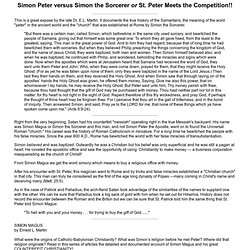
E.L. Martin. It documents the true history of the Samaritans, the meaning of the word "peter" in the ancient world and the "church" that was established at Rome by Simon the Sorcerer. "But there was a certain man, called Simon, which beforetime in the same city used sorcery, and bewitched the people of Samaria, giving out that himself was some great one: To whom they all gave heed, from the least to the greatest, saying, This man is the great power of God. And to him they had regard, because that of long time he had bewitched them with sorceries.
Right from the very beginning, Satan had his counterfeit "messiah" operating right in the true Messiah's backyard. Simon believed and was baptized. From Simon Magus we get the word simony which means to buy a religious office with money. After his encounter with St. Lindsey Williams. The Difference between Aliens, Demons and Fallen Angels.
The Difference Between Fallen Angels, Demons, Aliens, Jedi, and the Watchers By Sherry Shriner In these last days, the Bible says it will be a time of mass hybridization and the mixture and corruption of human DNA by fallen angels, also known as "Aliens.
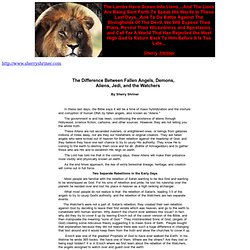
" The government is and has been, conditioning the existence of aliens through Hollywood, science fiction, cartoons, and other sources. However, they are not telling you the whole truth. These Aliens are not ascended masters, or enlightened ones, or beings from galaxies millions of miles away, nor are they our forefathers or original creators. The Lord has told me that in the coming days, these Aliens will make their presence more visibly and physically known on earth. What is Disaster Risk Reduction? Disaster risk reduction (DRR) There is no such thing as a 'natural' disaster, only natural hazards.
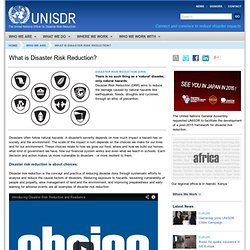
Disaster Risk Reduction (DRR) aims to reduce the damage caused by natural hazards like earthquakes, floods, droughts and cyclones, through an ethic of prevention. Disasters often follow natural hazards. A disaster's severity depends on how much impact a hazard has on society and the environment. The scale of the impact in turn depends on the choices we make for our lives and for our environment. Disaster risk reduction is about choices. Disaster Risk Reduction. Natural disasters are a leading cause of hunger and affect all dimensions of food security including access to food, availability and stability of supplies, and nutrition.

Most food insecure people live in areas prone to natural hazards and they are the least able to cope with shocks. Due to their vulnerability and limited capacity to manage risks, poor households are often trapped in a downward spiral of food insecurity and poverty. Globally, disaster risk is increasing due to climate change and population growth and disaster frequently bring with them a food crisis. Yet there is increasing evidence that investments in reducing risk are cost effective.
Studies show that one dollar invested today in disaster risk reduction saves four dollars or more in relief and rehabilitation costs in the future. Disaster Risk Reduction Programs - PCI. We Can Predict The Future… And Prepare For It BECAUSE DISASTERS DO DISCRIMINATEReducing Vulnerability and Reinforcing Local Capacity to Respond to Emergencies In many countries where PCI works, even small shocks and stresses can have devastating and long-term effects on families – their health, safety, livelihoods, access to clean water and sanitation, food and housing.

PCI provides humanitarian assistance to people affected by disasters and complex emergencies; helps governments, local organizations, and communities better manage risk and respond to emergencies when they arise; and integrates efforts to help reduce vulnerability to disasters into all of its ongoing programs. PCI’s humanitarian assistance programs address protection for vulnerable populations; water, sanitation and hygiene; health; shelter and housing; livelihoods; and education in emergencies.
Disaster Risk Reduction Program. Philippines_ndrrmp_2011_2028. Disaster Risk Reduction (DRR) Programme. WMO Disaster Risk Reduction Programme The paradigm shift from post disaster response to a proactive risk reduction approach requires meteorological, hydrological and climate services to support science-based risk management decisions, as well as investments in early warning systems (Figure 2).
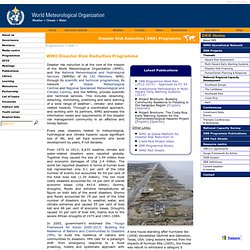
An increasing number of countries are taking steps at national to local levels to reduce risks associated with natural hazards. Among issues hampering these efforts is a lack of data concerning a country’s past climate to quantify hazard characteristics (e.g., frequency, severity and location) of local climatic extremes in the future. Disaster risk reduction is therefore one of the high priorities for the development of the Global Framework for Climate Services, to meet both the growing needs and opportunities to increase disaster resilience. Figure 2: Elements of a comprehensive DRR Framework based on the Hyogo Framework for Action 2005-2015. Advisory Support. Bridging the gap: UN-SPIDER's Technical Advisory Support UN-SPIDER was created in 2006 recognizing that disaster-risk management and Emergency response communities, particularly in developing countries, are not yet fully taking advantage of space-based information.
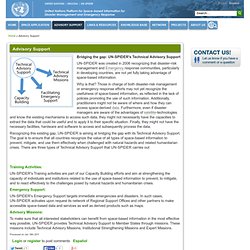
Why is that? Those in charge of both disaster-risk management or emergency response efforts may not yet recognize the usefulness of space-based information, as reflected in the lack of policies promoting the use of such information. Additionally, practitioners might not be aware of where and how they can access space-derived data.